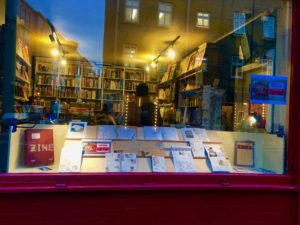今回もUrbana-London-Shizuokaを繋いでの放送。スタジオではトラブルが……
放送開始前にWRFUから「スタジオのPCが壊れた」というメールがあったとのことで、Tomさんが奮闘して放送にこぎつけることができましたが、今日は(今日も)数分遅れのスタートでした。ストリーミング配信には開始までもう少し長いラグがあったようです。ご心配をおかけしました。
Londonのbookartbookshopで、1/24 (木)にSKU Fieldwork Project(甲南大学「フィールドワーク研究」授業)から生まれたzineなどを展示しました。詳しいリポートはブログなどでお伝えします。
Part1, インフルエンザ流行中?, C-Uイベント情報
C-Uイベント情報
日本ではインフルエンザ流行が全国的に「警報レベル」に達しているそうで (インフルエンザ流行レベルマップ 第3週 – 国立感染症研究所)、ロンドンでも体調を崩している人がちらほらいるとか。Alexさんからも、風邪をひいたとのメールが。一年で一番、寒い時期だったりもします。みなさまも暖かくしてお過ごしください。
◎ 是枝裕和監督『万引き家族』(Shoplifter)@ The Art Theater: 1/26 (土) 7pm-、27 (日) 2:30pm-、28 (月) 5pm-、30 (水) 7:30pm-、31 (木) 4pm- @ The Art Theatre (126 W. Church St. Champaign, IL 61820) tel: (217) 355-0068
◎ Japanese Story Time: 1/26(土)2:00-2:45pm @ Megan’s Reading Room, Urbana Free Library (210 W. Green St., Urbana) “Come and listen to the stories かさじぞう (Grateful Statues) and かぐやひめ (The bamboo princess), the song お弁当のうた (Lunch Box Song), and make Winter Origami!”
◎ In Concert at CPL:Jason Finkelman: 1/27 (日) 2-3pm @Robeson Pavilion Room A&B, Champaign Public Library (200 W. Green St., Champaign)
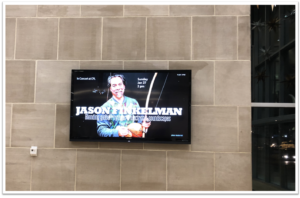
In Concert at CPL:Jason Finkelman@Main Library, Robeson Pavilion Room A&B, Jan.27(Sun) 2019
Manga &Martial Artist Kofiさん(後半)
今週のトークは、アメリカのコミックと日本の漫画の違いについて、熱く、爽やかに話します。今回も、Kofiさんが英語でまとめてくれました。
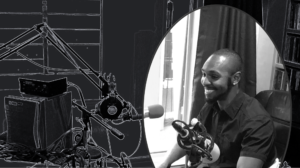
Kofiさん、漫画への想いは熱いけれど、トークは爽やか@WRFU Studio, Dec.28, 2018
Part2, 漫画とコミックの違い、起承転結の「転」、擬音語、劇画とセリフ
Kofi explains that American comics and Japanese Manga are different in many ways. An obvious difference is the art style; however this is not what truly separates Comics and Manga.
One of the main differences between Japanese and Western comics is that Japanese Manga uses the Kishoutenketsu (起承転結) storytelling format. Kishoutenketsu differs from Western Storytelling (Introduction, Conflict, Resolution) in that the “twist” is the most important aspect and “conflict” is not written into the internal structure.
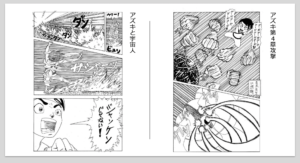
Kofi作『アズキ』より抜粋
He says that another unique thing about manga is the use of 擬音語 Giongo, which are sound effects using Japanese Onomatopoeias. Giongo are truly a part of the artwork. Kofi uses Giongo in his manga but explains that it is difficult as a non-native Japanese speaker. However, there is an online database with thousands of Giongo that he uses for research.
Further, Western comics often rely more on text, whereas manga uses pictures with minimal dialogue to tell the story. Manga uses cinematographic techniques adapted from Western cinema by the Godfather of Manga, Osamu Tezuka, to create drama and dynamism.When asked how he comes up with ideas for stories Kofi explained that he usually imagines his characters in conversation first. He takes walks and imagines the story he is creating play in his head as an anime.
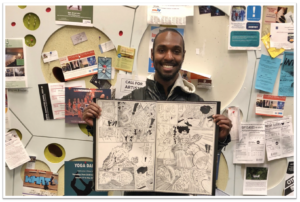
Mangaの話、楽しかった!@UCIMC, Urbana, Dec.28, 2018
His new Manga “Azuki” is about a little girl who is a Rock, Paper, Scissors champion. He recently had several copies of the first book printed and is currently drawing book #4. If interested in reading Azuki please visit Kofi’s new website or follow him on Instagram @ kofi.manga to keep up with his artwork.While continuing his education and career as an artist, Kofi is hoping to return to Japan through a study abroad program. by Kofi
Part3, コメント
日本のマンガとアメリカのコミックの違い?
Kofiさんがトークで話していたように、日本のマンガとアメリカのコミックはセリフの量にも違いがあるかもしれません。アメリカのコミックは、吹き出しの中でも小説のセリフと同じぐらいの分量を喋ったりします。また、個人で執筆したりしている場合は異なるかもしれませんが、商業的には、伝統的にストーリー作家(文章を書く人)とアーティスト(絵を描く人)の分業になっていると思います。
擬音語に関しては、翻訳する際には訳さず、そのまま絵の一部として残すこともあるようですね。(訳すのが難しい、ということの他に、マンガの擬音語は写植でなく書き文字なので、変更するのが難しい、というのもあるかもしれません。) – by Ryuta
Kofiさん、またHarukana Showに出演して、新しい作品や、(日本に行ったら)日本のことも話してください。よろしくお願いします!
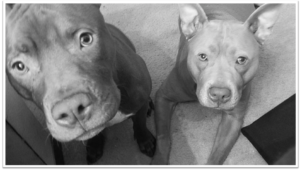
イヌが好きというKofiさんから届いた写真、ボクサーの目をしてるなあ
今週の音楽も先週と同じフォーマット「A.真面目な漫画、B.アクションシーンを描く時、C.毎日きく好きな歌手の曲」でお送りしました。選曲はMugiko & Ryutaです。(山崎ハコはKofiさんもよく聴くそうです。)
■Rodorigo (作曲)「Fantasia para un Gentilhombre 第1楽章」■Yoonmirae「Kawibawibo」■山崎ハコ「飛びます」

